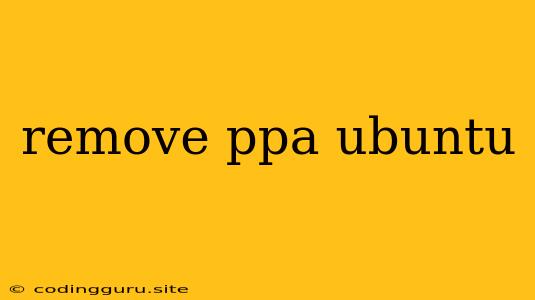Removing PPAs from Your Ubuntu System: A Comprehensive Guide
Personal Package Archives (PPAs) are a convenient way to install software not included in the default Ubuntu repositories. However, they can sometimes cause issues or become outdated, necessitating their removal. This article provides a step-by-step guide on how to safely remove PPAs from your Ubuntu system.
Understanding PPAs
Before diving into the removal process, let's understand what PPAs are. A PPA is essentially a repository maintained by an individual or developer that offers software not included in the standard Ubuntu repositories.
Why might you need to remove a PPA?
- Outdated software: PPAs can sometimes lag behind the latest releases of software.
- Conflicts: A PPA may conflict with other software installed on your system.
- Security concerns: Some PPAs might contain software that is untrusted or potentially unsafe.
- Unnecessary software: You might have installed software from a PPA and no longer require it.
Identifying Installed PPAs
The first step in removing a PPA is to identify which ones are installed on your system. This can be done using the following commands:
sudo apt update
sudo apt list --installed | grep "ppa:"
This command lists all installed packages and their sources, highlighting those installed from PPAs.
Removing PPAs
Once you know the PPAs you wish to remove, you can use the ppa-purge command. This is a powerful tool designed specifically for removing PPAs and their associated packages.
Here's how to use ppa-purge:
-
Install
ppa-purge:sudo apt install ppa-purge -
Remove the PPA:
sudo ppa-purge ppa:username/ppa-nameReplace
username/ppa-namewith the actual name of the PPA you wish to remove. For example, to remove theppa:webupd8team/javaPPA:sudo ppa-purge ppa:webupd8team/java
Manually Removing Packages
In some cases, you might need to manually remove packages associated with a PPA. This is usually necessary if ppa-purge fails to remove all packages.
Here's how to do it:
-
Identify packages:
sudo apt list --installed | grep "ppa:username/ppa-name"This command lists all packages installed from the specified PPA.
-
Remove packages:
sudo apt remove package1 package2 ...Replace
package1 package2 ...with the names of the packages you want to remove. -
Clean up:
sudo apt autoremoveThis command removes any dependencies that are no longer needed.
Alternatives to ppa-purge
If you are unable to install ppa-purge or it doesn't work correctly, you can use alternative methods:
apt-get remove: This command can be used to remove specific packages associated with a PPA.sudo apt-get remove package1 package2 ...- Manual package removal: In some cases, you might need to manually remove packages associated with a PPA. This involves identifying the package names and using the
apt-get removecommand.
Precautions and Tips
- Back up your system: It is always a good idea to back up your system before removing PPAs.
- Be careful with
apt-get remove: Whileapt-get removecan be used to remove packages, it might not always remove all dependencies. - Avoid removing PPAs you're unsure about: If you're unsure about the purpose of a PPA, it's best to leave it alone.
- Don't remove essential PPAs: Some PPAs are essential for the proper functioning of your system. Avoid removing them unless you are absolutely sure you can do so safely.
Conclusion
Removing PPAs from your Ubuntu system is a straightforward process that can help resolve software conflicts and ensure your system's stability. By following the steps outlined in this guide, you can safely remove any unnecessary or problematic PPAs. Remember to always use caution when modifying your system's software repositories, and back up your system before making significant changes.
